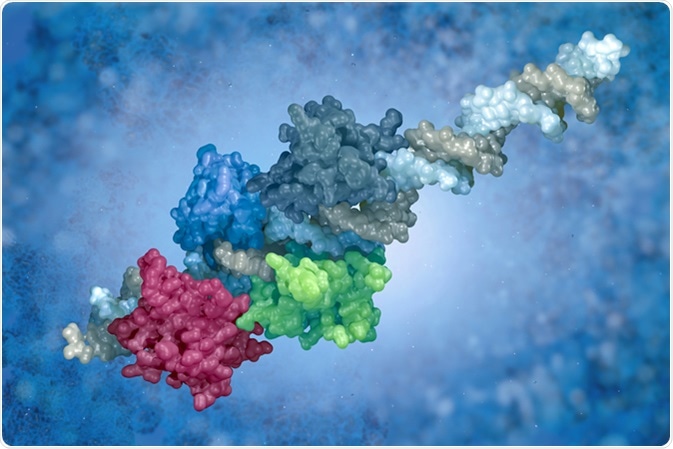
Role of Transcription Factors
Transcription refers to the creation of a complimentary strand of RNA copied from a DNA sequence. This results in the formation of messenger RNA (mRNA), which is used to synthesize a protein via another process called translation.

DNA-protein complex. Surface representation of transcription factors (interferon regulatory factors) bound to the interferon-beta enhancer; rendered from PDB structure 2O6G. Image Credit: vitstudio / Shutterstock
Transcription factors are vital molecules in the control of gene expression, directly controling when, where and the degree to which genes are expressed. They bind to specific sequences of DNA and control the transcription of DNA into mRNA. The gene expression is regulated through either activation or repression of transcription factors, which are essential for a range of key cellular processes.
The activation or inhibition of many transcription factors is controlled by signal transduction pathways. Co-factors also regulate them by forming complexes that can activate or repress transcriptional activity.
RNA Polymerase
Using DNA as a template, an enzyme called RNA polymerase catalyzes the chemical reactions that enable the production of RNA. Transcription factors determine where, when and how effectively this enzyme functions.
Transcription Factor Function
Transcription factors are essential to cellular function, to how the body responds to disease and to the healthy development of an organism. Transcription factors include a diverse range of proteins and generally perform their functions while in protein complexes made up of multiple subunits. The complexes bind to parts of the DNA called “promotor” regions, which are situated upstream of a gene’s coding region. They may also directly bind to RNA polymerase. In this way, they activate or inhibit gene transcription, which determines whether or not the gene functions.
In eukaryotes, basal transcription factors are required for RNA to perform its role at a transcription site. Basal transcription factors are considered the most basic group of proteins required for transcription to be activated and examples include transcription factor II A (TFIIA) and transcription factor II B (TFIIB). Researchers have made much progress in defining the specific functions performed by the complexes these basal transcription factor form.
Homeotic Transcription Factors
When a multicellular organism is developing, the fate of individual cells is determined by transcription factors. How body formation occurs, for example, is controlled by homeotic genes, which code for transcription factors that instruct cells to form different body parts. These proteins can activate one gene, but inhibit another gene, thereby generating the complementary effects that are needed for an organism to develop in an ordered way. If a homeotic transcription factor is mutated, abnormal development occurs.
Role in Oncogenesis
If transcription factors alter the activity of genes that play a role in the cell division cycle, they can be a significant contributor in oncogenesis. They can also be the oncogene (cancer-causing gene) products or the products of tumor suppressor genes.
Transcription Factor Regulation
Transcription factors perform their roles in the cell nucleus, where genes are located, and their nuclear import or export can influence the activity of genes. Another mechanism that is key to regulating transcription factor activity is phosphorylation. Furthermore, as well as having the ability to control the genes and transcriptional activity of other transcription factors, these complexes can regulate the genes that control their own transcription, resulting in intricate mechanisms of feedback control.
Transcription factors are involved in a wide range of bodily processes including development, immunity and the body’s response to stress. Analysis of transcription factor expression, activity, regulation and gene sequence can help researchers establish the significance of the roles they play in disease processes.
Reviewed by Chloe Barnett, BSc
Sources
Further Reading
Last Updated: Jun 8, 2018























.png)











No hay comentarios:
Publicar un comentario